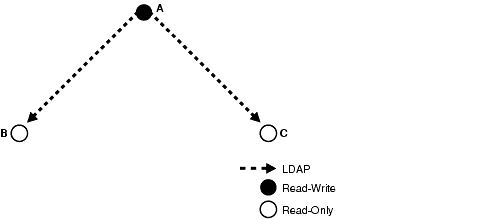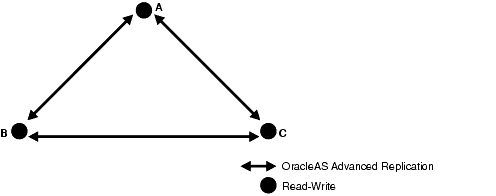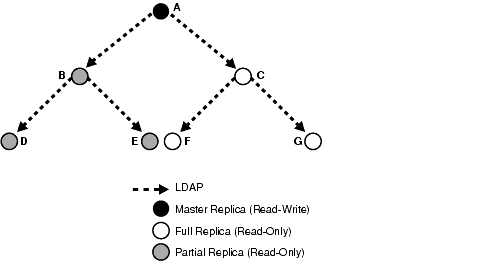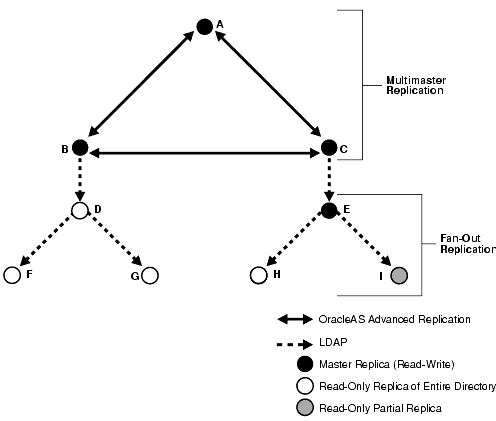10g (9.0.4)
Part Number B12118-01
Home |
Solution Area |
Contents |
Index |
| Oracle® Internet Directory Administrator's Guide 10g (9.0.4) Part Number B12118-01 |
|
Directory Replication Concepts, 4 of 12
This section contains these topics:
In a directory replication group, the protocol for transferring data can be based on either Oracle9i Advanced Replication or LDAP. Table 24-2 shows how each type handles various features of replication and points to sections of this chapter with more details.
| Feature | LDAP-Based Replication | Oracle9i Advanced Replication-Based Replication | More Information |
|---|---|---|---|
|
Change propagation |
Change propagation from supplier to consumer happens over LDAP |
Change propagation from supplier to consumer happens by using Oracle9i Advanced Replication |
|
|
Replica type supported |
Read-only partial replica |
Read/write full replica |
|
|
Configuration supported |
Fan-out replication |
Single-master replication, by switching all masters in a multimaster configuration except one to read-only mode. |
"Single-Master Replication Groups" |
A single-master replication group has only one supplier replica supplying changes to one or more consumers. Clients can update only the master replica, and can only read data on any of the consumers.
Figure 24-2 shows a single-master replication environment.

In Figure 24-2, each bullet represents a node of Oracle Internet Directory. Node A is a supplier that replicates consumer nodes B and C. Node A is read/write, and Nodes B and C are read-only. The data transfer protocol is LDAP.
A multimaster replication group, also called a peer-to-peer or n-way replication group, has two or more nodes acting as equals to manage groups of replicated data. In a multimaster replication group, each directory server is both a supplier and a consumer of changes, and the entire directory is replicated on each node.
The example in Figure 24-3 shows three nodes--A, B, and C--that update each other in a multimaster replication group.

In Figure 24-3, each node is read/write, and the data transfer protocol is based on Oracle9i Advanced Replication.
|
Note: Multimaster replication is the only replication mechanism supported in Oracle Application Server Single Sign-On as described in the section "Configuring Oracle Application Server Single Sign-On for Replication" in the chapter on high availability in the Oracle Application Server Single Sign-On Administrator's Guide |
|
See Also:
"Multimaster Replication" for more information about multimaster replication |
A fan-out replication group, also called a point-to-point replication group, has a supplier replicating directly to a consumer. That consumer can then supply the same data to one or more other consumers. The replication can be either full or partial.
Figure 24-4 shows a fan-out replication environment.

In Figure 24-4, supplier A replicates to two consumers, B and C. Consumer node B contains a partial replica of A, whereas consumer node C contains a full replica of A. Both consumer nodes B and C are read-only.
Each of these nodes, in turn, serves as a supplier that replicates data to two other consumers: Node B partially replicates to nodes D and E, and node C fully replicates to nodes F and G.
In fan-out replication, nodes transfer data by using LDAP.
Table 24-3 compares multimaster, single-master, and fan-out replication.
Oracle Internet Directory Release 9.0.4 enables any node in a multimaster replication group to supply all or part of its data to a read-only consumer. This consumer can, in turn, supply data to other consumers in a fan-out configuration. Within the multimaster replication agreement, data transfer between the nodes occurs by way of Oracle9i Advanced Replication. Within the fan-out replication agreement, data transfer from supplier to consumer occurs by way of LDAP.
Figure 24-5 shows an example of multimaster replication used in conjunction with fan-out replication.

In the example in Figure 24-5, nodes A, B, and C form a multimaster replication group. They transfer data between them by using Oracle9i Advanced Replication.
Node B supplies changes to Node D, a read-only replica of the entire directory. Node D, in turn, supplies changes to Nodes F and G by using LDAP-based replication. Both Nodes F and G are read-only replicas of the entire directory. Similarly, Node C supplies changes to node E, a read/write replica of the entire directory. Node E, in turn supplies changes to Node H, a read-only replica of the entire directory, and Node I, a read-only partial replica, by using LDAP-based replication.
|
See Also:
"Fan-Out and Partial Replication" for more information about fan-out replication |
|
|
 Copyright © 1999, 2003 Oracle Corporation. All Rights Reserved. |
|